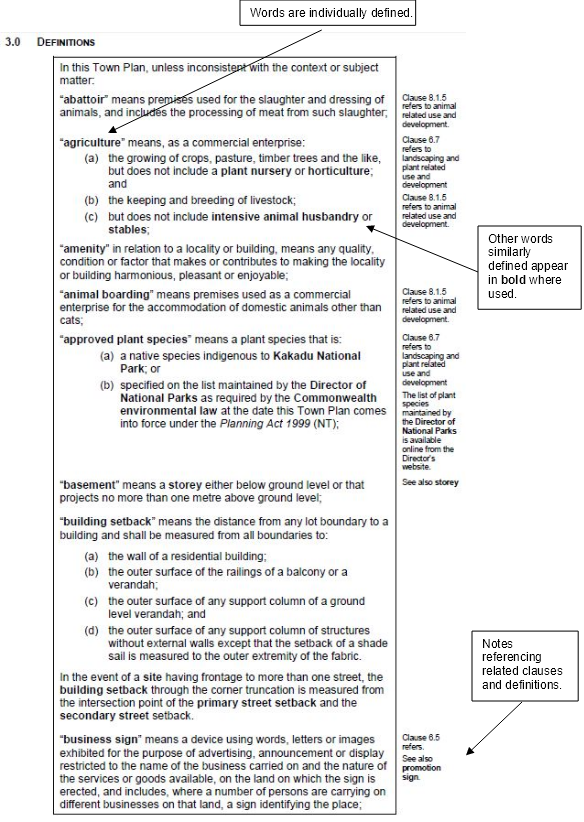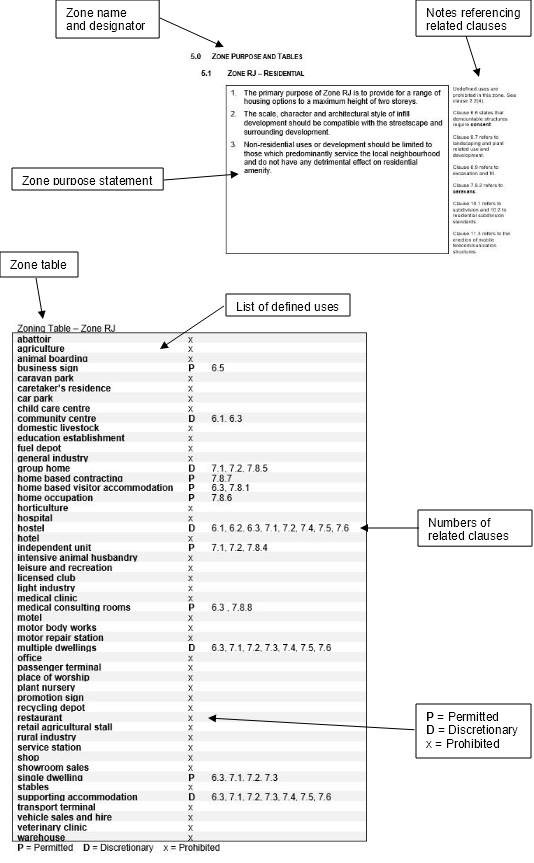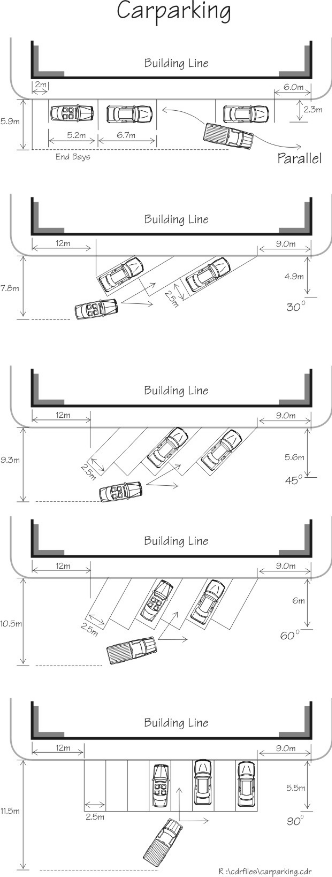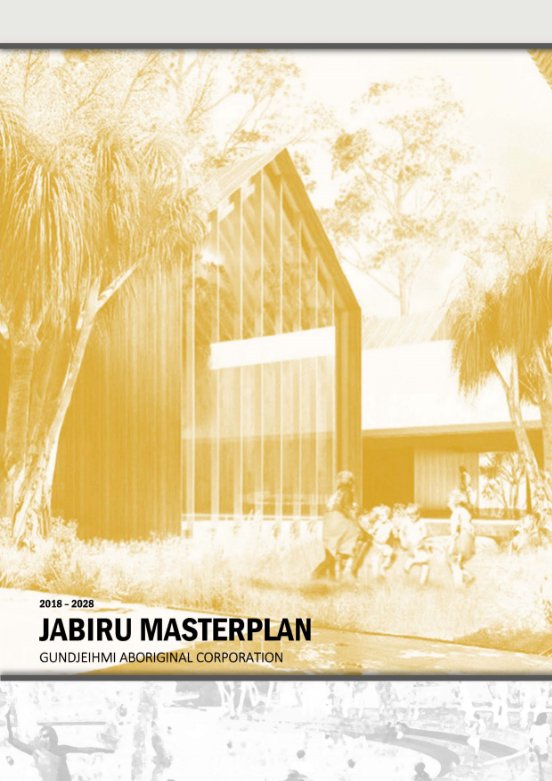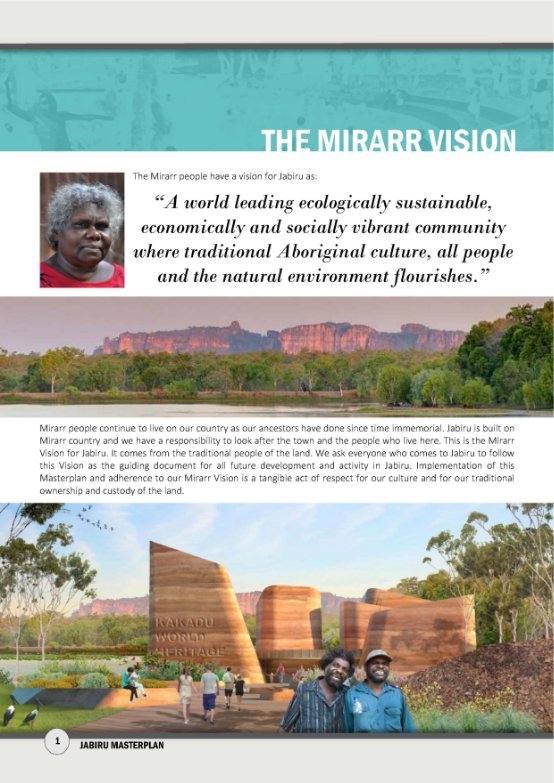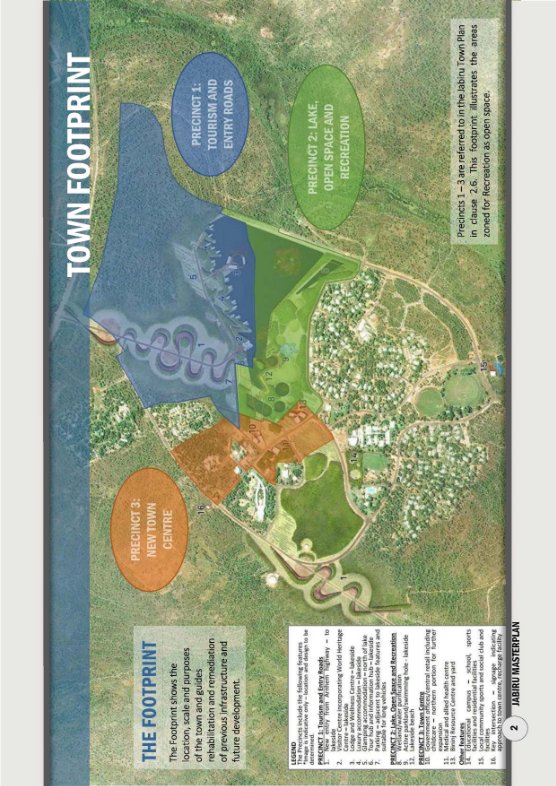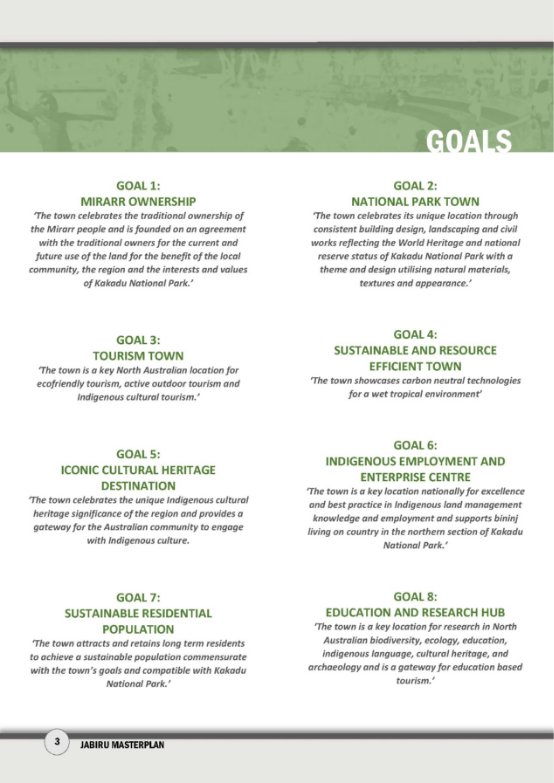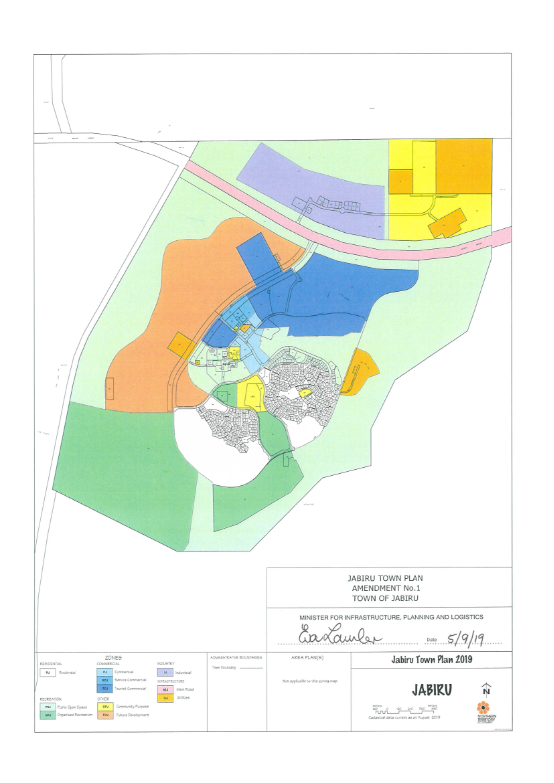| In this Town Plan, unless inconsistent with the context or subject matter: | |
| “abattoir” means premises used for the slaughter and dressing of animals, and includes the processing of meat from such slaughter; | Clause 8.1.5 refers to animal related use and development. |
| “agriculture” means, as a commercial enterprise: (a) the growing of crops, pasture, timber trees and the like, but does not include a plant nursery or horticulture; and (b) the keeping and breeding of livestock; (c) but does not include intensive animal husbandry or stables; | Clause 6.7 refers to landscaping and plant related use and development Clause 8.1.5 refers to animal related use and development. |
| “amenity” in relation to a locality or building, means any quality, condition or factor that makes or contributes to making the locality or building harmonious, pleasant or enjoyable; | |
| “animal boarding” means premises used as a commercial enterprise for the accommodation of domestic animals other than cats; | Clause 8.1.5 refers to animal related use and development. |
| “approved plant species” means a plant species that is: (a) a native species indigenous to Kakadu National Park; or (b) specified on the list maintained by the Director of National Parks as required by the Commonwealth environmental law at the date this Town Plan comes into force under the Planning Act 1999 (NT); | Clause 6.7 refers to landscaping and plant related use and development The list of plant species maintained by the Director of National Parks is available online from the Director’s website. |
| “basement” means a storey either below ground level or that projects no more than one metre above ground level; | See also storey |
| “building setback” means the distance from any lot boundary to a building and shall be measured from all boundaries to: (a) the wall of a residential building; (b) the outer surface of the railings of a balcony or a verandah; (c) the outer surface of any support column of a ground level verandah; and (d) the outer surface of any support column of structures without external walls except that the setback of a shade sail is measured to the outer extremity of the fabric. In the event of a site having frontage to more than one street, the building setback through the corner truncation is measured from the intersection point of the primary street setback and the secondary street setback. | |
| “business sign” means a device using words, letters or images exhibited for the purpose of advertising, announcement or display restricted to the name of the business carried on and the nature of the services or goods available, on the land on which the sign is erected, and includes, where a number of persons are carrying on different businesses on that land, a sign identifying the place; | Clause 6.5 refers. See also promotion sign. |
| “caravan” includes a vehicle registered or eligible for registration within the meaning of the Motor Vehicles Act 1999 (NT) which is designed or adapted for human habitation; | Clause 7.8.2 limits the use of caravans outside caravan parks. |
| “caravan park” means land used for the parking of caravans or the erection or placement and use of tents or cabins for the purpose of providing accommodation; | |
| “caretaker’s residence” means a dwelling which is ancillary to the lawful use of the land on which it is erected and which is used by the caretaker of the land; | Clause 7.8.3 limits the floor area of caretaker’s residences. |
| “car park” means the parking of motor vehicles otherwise than as an ancillary use of land; | Clause 6.3.3 specifies criteria relating to parking layout. |
| “car parking area” means an area set aside or designated for the parking of three or more motor vehicles; | Clause 6.3.3 specifies criteria relating to parking layout. |
| “car parking space” means a space designated for the parking of one motor vehicle; | NT building legislation may require compliance with the Building Code of Australia for the provision of disabled car parks. |
| “child care centre” means premises used for the caring for 6 or more children; | Clause 8.1.4 specifies criteria relating to the use. |
| “common building boundary” means the designated boundary between one lot and an adjoining lot in the same subdivision; | Clause 10.1.2 provides for lots of less than 800m2. |
| “Commonwealth environmental law” means the Environment Protection and Biodiversity Conservation Act 1999 (Cth), the Environment Protection and Biodiversity Conservation Regulations 2000 (Cth), and management plans for the Kakadu National Park in force from time to time under that Act; | |
| “community centre” means a building or part of a building designed or adapted primarily to provide facilities for social, sporting or cultural purposes but does not include premises licensed under the Liquor Act 1978 (NT); | |
| “consent” means the consent of the consent authority within the meaning of the Planning Act 1999 (NT); | |
| “Director of National Parks” means the entity of that name continuing under the Commonwealth environmental law; | |
| “demountable structure” means a building, including transport containers, which is wholly or substantially prefabricated and which is designed to be transported from site to site, but does not include a caravan or transportable module used in conjunction with an education establishment or as a medical clinic or as a construction site office or a prefabricated dwelling; | Clause 6.6 refers to the placement of demountable structures. |
| “domestic livestock” means the keeping, exercising or training, other than as a commercial enterprise, of any of the following: (a) horses or other equine animals; (b) ox, buffalo or other bovine animals; (c) camels; or (d) pigs; | Clause 8.1.5 refers to animal related use and development. |
| “dwelling” means a building, or part of a building, designed, constructed or adapted as a self-contained residence; | |
| “education establishment” means an academy, college, kindergarten, lecture hall, primary or secondary school, technical college or university, but does not include a place of worship; | |
| “floor area” in relation to a building, includes all wall thicknesses of the external walls and all roof areas used as floors, but does not include verandahs, balconies or areas set aside for car parking or access thereto; | See also net floor area. |
| “fully screened’, in relation to a verandah or balcony, means a permanently fixed durable external screen, designed and coloured to blend in with the development to at least 1.7m above floor level, which is no more than 25% transparent and consists of perforated panels or trellis with a maximum of 25% openings or solid translucent panels or louvered slats, which are only able to be opened at 450 angle and do not allow direct overlooking into an adjacent residential building; | |
| “fuel depot” means a depot for the storage or sale of solid, liquid or gaseous fuel, but does not include a service station; | Clause 8.1.3 refers to fuel and vehicle repair related use and development. |
| “general industry” means an industry other than a light industry or a rural industry; | See also industry, light industry and rural industry. Clause 9.1.2 refers to biosecurity and contamination risks of industry use and development |
| “ground level” means the ground surface level that exists on a site prior to the commencement of earth or construction works associated with the development of a building; | Clause 7.1 refers to the measurement of residential building height |
| “group home” means a dwelling: (a) occupied by persons who are not necessarily related and who live together as a single household, with or without paid supervision or care; and (b) where management of the household is assisted by a community organisation, education establishment, or recognised religious or charitable organisation, or a department or institutional establishment of the Crown; but does not include supporting accommodation; | Clause 7.8.5 refers to the operation of the use. |
| “habitable room” means any room of a dwelling other than a bathroom, laundry, toilet, pantry, walk-in wardrobe, corridor, stair, lobby, photographic darkroom, clothes drying room or other space of a specialised nature occupied neither frequently nor for extended periods; | |
| “home based contracting” means the storage on the site of a dwelling of materials and/ or vehicles associated with a business operated by a person resident in the dwelling, but which business does not operate on the site of the dwelling; | Clause 7.8.7 refers to the operation of the use. |
| “home based visitor accommodation” means temporary accommodation provided on the premises of a dwelling by the resident of that dwelling, as a commercial enterprise for persons away from their normal place of residence but does not include a hostel; | Clause 7.8.1 specifies criteria relating to the use |
| “home occupation” means an occupation or profession which is carried on in a dwelling or on the site of a dwelling by a person resident in the dwelling and may include the caring for up to five children including children who reside in the dwelling; | Clause 7.8.6 refers to the operation of the use. |
| “horticulture” means the commercial cultivation of fruit, vegetables, flowers and the like; | See also agriculture. Clause 6.7 refers to landscaping and plant related use and development |
| “hospital” means a building used to provide health services including preventative care, diagnosis, medical and surgical treatment and counselling to persons admitted as in-patients; | |
| “hostel” includes boarding houses, guest houses, lodging houses and other premises used to provide board or lodging with communal toilet, ablution, dining or cooking facilities but does not include bed and breakfast accommodation or a group home; | |
| “hotel” means premises which require a licence under the Liquor Act 1978 (NT) and where, as a principal part of the business, alcoholic beverages are ordinarily sold to the public for consumption on the premises whether or not accommodation is provided for members of the public and whether or not meals are served, but does not include a licensed club, motel or restaurant; | |
| “independent unit” means an ancillary dwelling constructed on the same site as a single dwelling; | |
| “industry” includes the following operations: (a) the carrying out of a process of manufacture whether or not to produce a finished article; (b) the dismantling of an article, machinery or vehicle; (c) the treatment of waste materials; (d) the packaging of goods or machinery; (e) the process of testing or analysis of an article, goods or materials; (f) the storage of goods, equipment or vehicles not in association with any other activity on the site, but not including transport terminal, vehicle sales and hire or warehouse; and if on the same land as any of the operations referred to in paragraphs (a) to (f) above: (g) the storage of goods used in conjunction with or resulting from any of the above operations; (h) the provision of amenities for persons engaged in the operations; (i) the sale of goods resulting from the operations; (j) any work of administration or accounting in connection with an operation; and (k) an industry or class of industry particularly described in this Town Plan; but does not include motor body works, motor repair station or a home occupation; | See also general industry, light industry and rural industry. Clause 9.1.2 refers to biosecurity and contamination risks of industry use and development |
| “intensive animal husbandry” means: (a) the keeping and feeding of animals, including poultry and pigs, in sheds, stalls, ponds, compounds or stockyards; or (b) aquaculture; as a commercial enterprise; | Clause 8.1.5 refers to animal related use and development. |
| “Kakadu National Park” means the ‘Commonwealth reserve’ of that name continuing under the Commonwealth environmental law; | |
| “leisure and recreation” means the provision indoors or outdoors of recreation, leisure or sporting activities and includes cinemas, theatres, sporting facilities and the like as a commercial enterprise but does not include a licensed club or community centre; | |
| “licensed club” means premises used as club rooms which require a licence under the Liquor Act 1978 (NT); | |
| “light industry” means an industry in which the process carried on, the machinery used and the goods and commodities carried to and from the premises on which the industry is sited are not of such a kind as are likely to adversely affect the amenity of the surrounding locality or environment by reason of the emission of noise, vibration, smell, fumes, smoke, vapour, steam, soot, ash, dust, waste water, waste products, grit, oil, hazardous substance or otherwise; | See also general industry, industry and rural industry. Clause 9.1.2 refers to biosecurity and contamination risks of industry use and development |
| “Masterplan” means the masterplan for the Town of Jabiru attached to this Town Plan at Schedule 2; | |
| “medical clinic” means a building or place used by one or more medical practitioners, physiotherapists, dentists or persons ordinarily associated with health care, or their employees, but does not include a hospital; | |
| “medical consulting rooms” means a room or suite of rooms on the site of a single dwelling used by a resident of that dwelling for the purposes of his or her work as a medical practitioner, dentist or person ordinarily associated with health care; | Clause 7.8.8 refers to the operation of the use. |
| “mezzanine” means an intermediate floor within a room; | See also storey |
| “motel” means premises wholly or principally used for the accommodation of travellers and the vehicles used by them, whether or not the building is also used to provide meals to the travellers or to members of the general public and whether or not the premises are licensed under the Liquor Act 1978 (NT), but does not include bed and breakfast accommodation; | |
| “motor body works” means premises for repairing the body work of motor vehicles and includes body building, panel beating or spray painting of motor vehicles; | Clause 8.1.3 refers to fuel and vehicle repair related use and development. |
| “motor repair station” means premises used for carrying out repairs to motor vehicles but does not include a motor body works or a transport terminal; | Clause 8.1.3 refers to fuel and vehicle repair related use and development. |
| “multiple dwellings” means a building or group of buildings on a site which individually or collectively contain more than one dwelling (including serviced apartments) but does not include a dependant unit; | Serviced apartments attract a different requirement for car parking. See clause 6.3.1 |
| “NT building legislation” means Northern Territory legislation that controls how structures are planned, built and valued in the Northern Territory, such as but not limited to the Building Act 1993 (NT) and the Building Regulations 1993 (NT); | |
| “net floor area” in relation to a building, includes all the area between internal surfaces of external walls but does not include: (a) stairs, cleaners cupboards, ablution facilities, lift shafts, escalators or tea rooms where tea rooms are provided as a standard facility in the building; (b) lobbies between lifts facing other lifts servicing the same floor; (c) areas set aside as public space or thoroughfares and not used exclusively by the occupiers of the building; (d) areas set aside as plant and lift motor rooms; (e) areas set aside for use of service delivery vehicles; and (f) areas set aside for car parking or access; | See also floor area. |
| “office” means a building or part of a building used for the conduct of administration whether public or otherwise, the practice of a profession, or the carrying on of mercantile, banking, insurance, legal, clerical or similar services, but does not include a home occupation; | |
| “passenger terminal” means premises used as a railway or bus station, airline passenger terminal, hoverport or heliport; | |
| “pergola” is an unroofed open structure constructed at ground level without external walls but may be covered with permeable shade cloth; | |
| “place of worship” means premises used as a church, chapel, mosque, temple, synagogue or place of religious instruction or worship or for the purpose of religious training; | |
| “plant nursery” means premises principally used for the growing and/ or display of plants for sale, whether or not seeds, equipment, soil, sand, rocks, railway sleepers or other associated products are displayed or sold, but does not include the use of land for agriculture or horticulture; | Clause 6.7 refers to landscaping and plant related use and development |
| “primary street” means the street or where there is more than one street, the street with the wider carriageway or that which carries the greater volume of traffic but does not include any street where access is prohibited by the controlling Agency; | See also secondary street |
| “plot ratio” means the floor area divided by the area of the site; | |
| “promotion sign” means a device using words, letters or images exhibited for the purpose of advertising, announcement or display which contains information relating to: (a) goods, services or products not provided, produced or sold; or (b) events or activities which are not carried out; on the land or in the building on which the sign is constructed or erected; | Clause 6.5 refers. See also business sign. |
| “recycling depot” means premises used for the collection, storage or sale of scrap metals, waste paper, rags, bottles or other scrap material or goods, or used for dismantling, storage or salvaging of machinery whether or not parts of them are for sale; | |
| “residential building” means a building or part of a building used or developed or proposed to be used or developed for a caretaker’s residence, group home, hostel, hotel (where the hotel includes accommodation available to members of the public), independent unit, motel, multiple dwellings, single dwelling or supporting accommodation; | Clause 7.1 refers to building heights and clause 7.2 to setback requirements. |
| “restaurant” means premises (other than a shop, or part of a hotel or a motel) in which meals are served to the public whether or not the premises provides a drive-through service or requires a licence under the Liquor Act 1978 (NT); | |
| “retail agricultural stall” means a building used for the display and retail sale of agricultural, market garden or horticultural produce grown on the land on which the building is erected; | Clause 6.7 refers to landscaping and plant related use and development |
| “rural industry” means an industry which involves the treatment, processing or packing of primary products transported to the site where the goods and commodities carried to and from the premises on which the industry is sited are not of such a kind as are likely to adversely affect the amenity of the surrounding locality; | See also general industry, industry and light industry. Clause 6.7 refers to landscaping and plant related use and development Clause 9.1.2 refers to biosecurity and contamination risks of industry use and development |
| “secondary street” means – in the case of a site that has access to more than one public street – the street or streets that are not the primary street; | See also primary street. |
| “serviced apartment” means a building (or part of a building) providing self-contained accommodation to tourists or visitors on a commercial basis and which is regularly serviced or cleaned by an owner or manager of the building or by an agent of an owner or manager of the building; | |
| “service station” means premises used for the sale by retail of fuels, oils and other products for use in connection with the operation of motor vehicles, whether or not it includes convenience shopping, but does not include a fuel depot, motor repair station or motor body works; | Clause 8.1.3 refers to fuel and vehicle repair related use and development. |
| “shop” means premises used for the display and sale by retail or for hire of goods or services but does not include a restaurant, retail agricultural stall, service station, showroom sales or vehicle sales and hire; | |
| “showroom sales” means the sale or hire in premises of goods of a bulky nature including: (a) furniture, floor coverings, furnishings, household appliances or camping gear; or (b) materials, tools, equipment or machinery for use in industry, commerce, the trades, primary production, medical purposes or party hire; | |
| “single dwelling” means a building containing one dwelling only; | |
| “site” means an area of land, whether consisting of one lot or more, which is the subject of an application to the consent authority; | |
| “sport and recreation” means the use of land for recreation purposes, but does not include such a use which involves commercial transactions, motor sports or activities which, by virtue of the generation of noise or disturbance, will adversely affect the amenity of adjoining land nor does it include leisure and recreation; | Clause 1.3.1(a)(ii) refers. |
| “stables” means premises used for the keeping, exercising or training of horses or other animals of burden but does not include domestic livestock or intensive animal husbandry; | Clause 8.1.5 refers to animal related use and development. |
| “storey” means that part of a building between floor levels. If there is no floor above, it is the part between the floor level and the ceiling. It may comprise an attic, basement or built over area for car parking; | |
| “supporting accommodation” means: (a) a convalescent or nursing home, an orphanage, a children’s home, an institution for poor or disadvantaged persons, or a home for the care of aged persons; or (b) premises used by people moving from their homes or an institution and living for a short time in shared, supporting or rehabilitating accommodation where day-to-day management and operation of the premises is provided by a community organisations or recognised religious or charitable organisation or a department or institutional establishment of the Crown; | |
| “telecommunications facility” means land used to accommodate: (a) any part of the infrastructure of a telecommunications network; or (b) any line, equipment, apparatus, tower, mast, antenna, tunnel, duct, hole, pit, pole or other structure or thing used, or for use, in or in connection with a telecommunications network; | Clause 11.3 refers to the development of telecommunication facilities |
| “transport terminal” means premises used for the: (a) loading, discharge or storage of goods in the course of the transport of those goods by air, road, rail or ship; (b) garaging and basic maintenance of fleet vehicles; or (c) servicing, repair and garaging of buses; | Clause 8.1.3 refers to fuel and vehicle repair related use and development. |
| “vehicle sales and hire” means premises used wholly or principally for the display for sale by retail or for rental of motor vehicles, caravans, trailers, farm machinery or boats but does not include motor body works, motor repair station, a shop or showroom sales; | Clause 8.1.3 refers to fuel and vehicle repair related use and development. |
| “veterinary clinic” means premises used for the medical treatment of animals, whether or not the animals are boarded there as part of the treatment; | Clause 8.1.5 refers to animal related use and development. |
| “warehouse” means premises used for the bulk storage of goods, or the display and sale of goods by wholesale. | |




